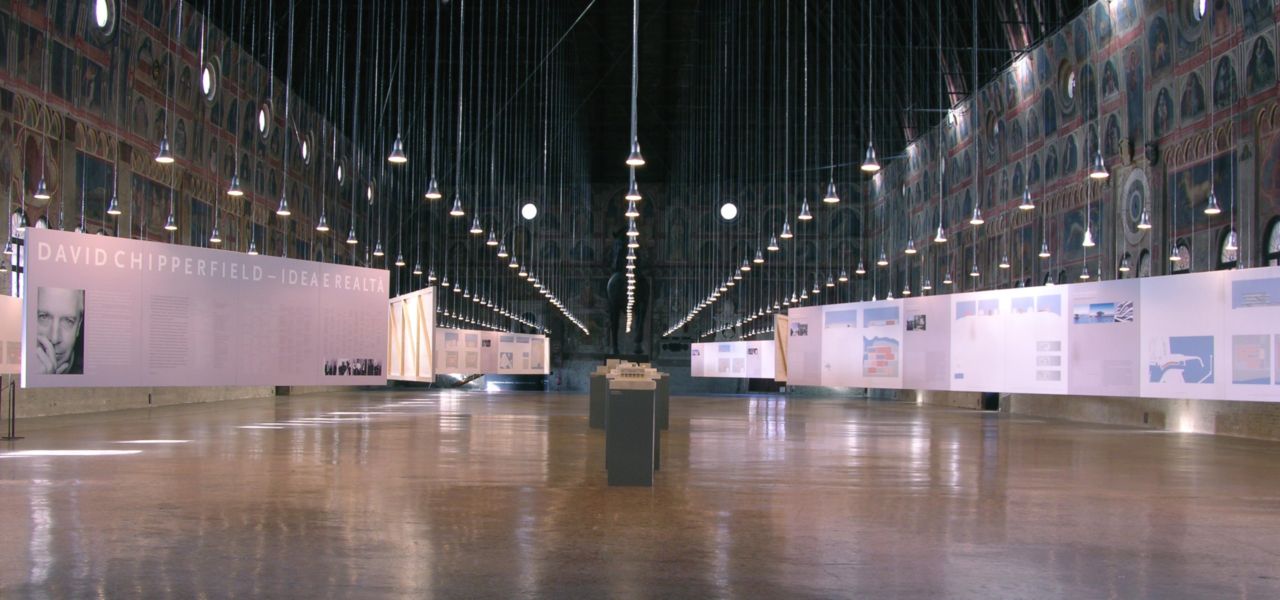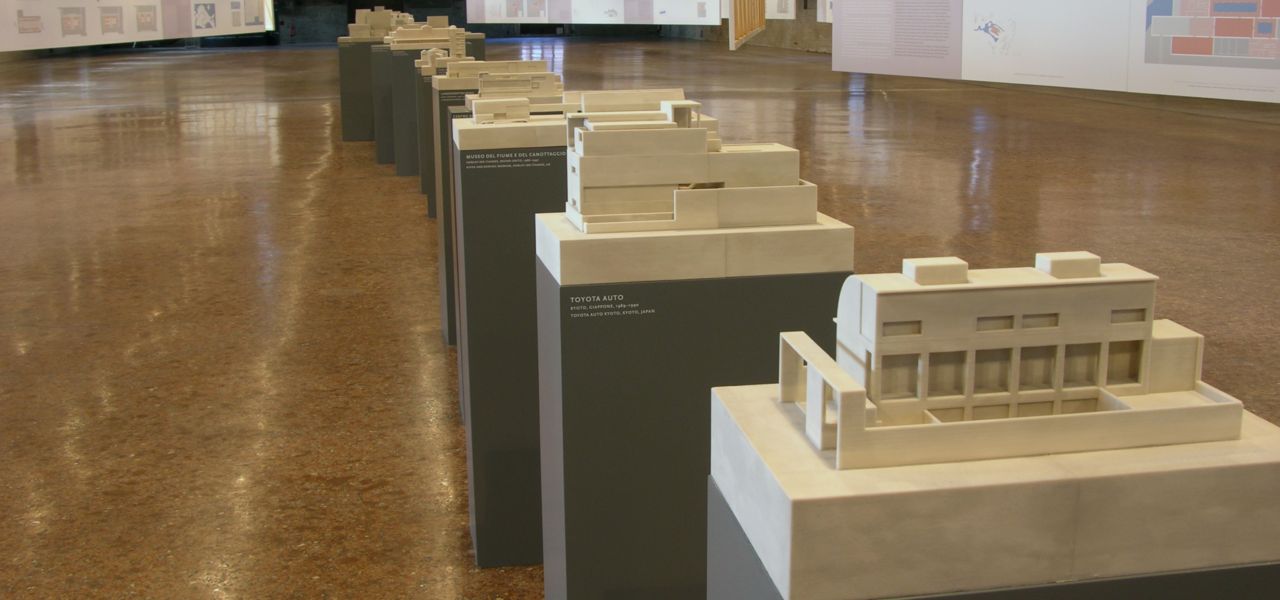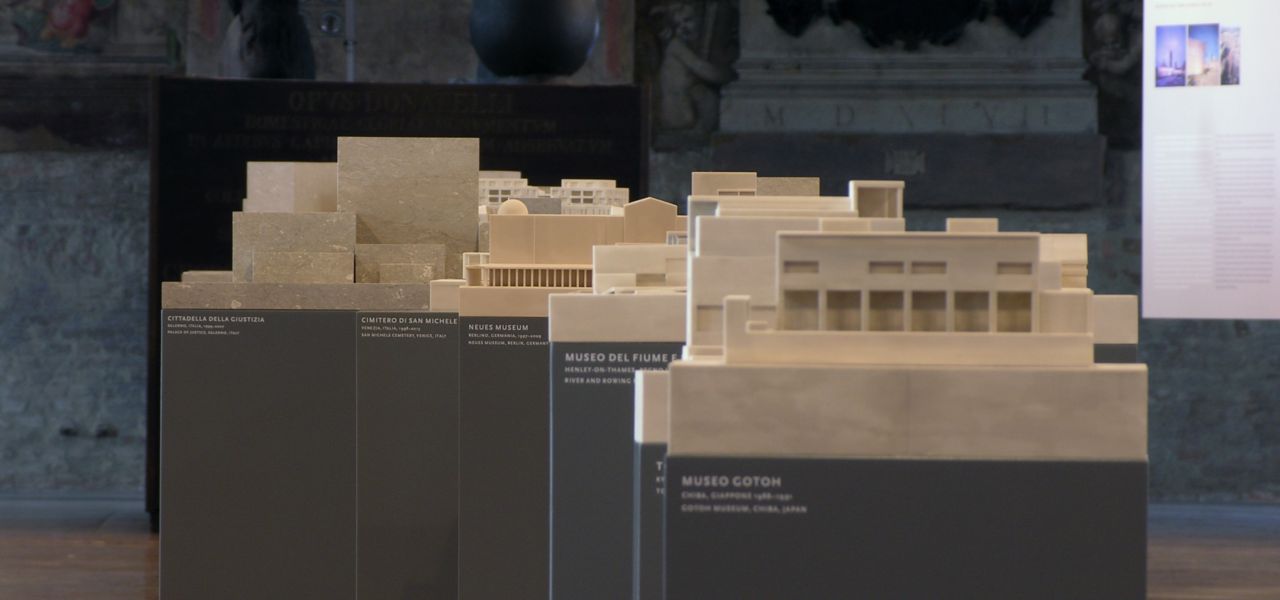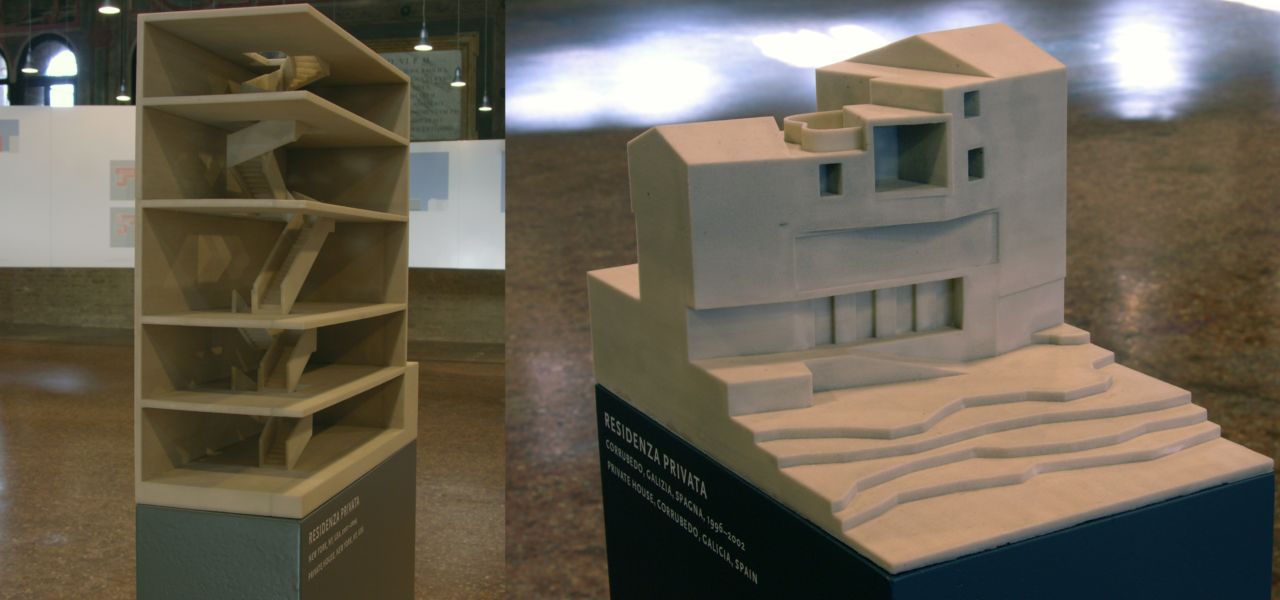Testo estratto da ARCHITETTI n. 1/2006 – Paginone centrale – Maggioli Editore
Un lapsus da lapide e gesso
I plastici/sculture delle architetture di David Chipperfield sviluppati con stampe 3D dal DIAPReM di Ferrara e dalla CMF Marelli di Cinisello Balsamo
Marcello Balzani, Matteo Fabbri
Fotografie di Christian Martuzzi
A Padova nell’ambito delle iniziative collegate al Premio Internazionale di Architettura “Barbara Capocchin”, l’architetto londinese David Chipperfield espone trentacinque progetti che tracciano il percorso di vent’anni di attività internazionale dello studio. La mostra “David Chipperfield: idea e realtà” è allestita presso il suggestivo spazio del Salone del Palazzo della Ragione. A promuoverla, l’Ordine degli Architetti Pianificatori e Paesaggisti della Provincia di Padova, il Comune di Padova, in collaborazione con Federico Motta Editore. L’allestimento di questa esposizione non è solo una semplice rassegna di architettura, ma l’occasione per tracciare un profilo aggiornato del lavoro della David Chipperfield Architects attraverso una selezione di progetti realizzati, in fase di costruzione o di progettazione. Insolita e innovativa la scelta dell’Architetto di rileggere la rappresentazione dei suoi lavori e proporre, in uno spazio affrescato, un allestimento semplice, “leggero”, ma di grande effetto.
Per l’occasione sono stati rielaborati tutti i disegni originali i quali, portati su tavole di grande formato, fanno da cornice ai plastici dei progetti, sistemati sulla prospettiva del salone, che guida lo sguardo allo scoperta delle architetture dello studio.
L’idea principale è quella di rappresentare in maniera semplice ed omogenea i progetti attraverso “disegni-pitture” e “plastici-sculture”, ponendo particolare attenzione alla forma e allo spazio. Pannelli illustrativi con fotografie e testi illustrano le idee guida dei progetti; in questa occasione lo studio ha scelto di presentare in anteprima diversi lavori: il Museo della Letteratura Moderna a Marbach (Germania), il Museo Figge a Davenport (USA), la Biblioteca Pubblica a Des Moines (USA) e l’edificio residenziale a Madrid (Spagna).
I plastici come sculture rappresentano una delle idee innovative proposte nell’allestimento; da sempre attenta alle nuove proposte tecnologiche, la David Chipperfield Architects ha cercato la metodologia migliore per realizzare questa idea. E’ nata quindi una sinergia con la CMF Marelli di Cinisello Balsamo, da anni importatrice della tecnologia di stampa tridimensionale ZCorporation, e con il DIAPReM (Development of Integrated Automatic Procedures for Restoration of Monuments) del Dipartimento di Architettura di Ferrara, che dal 2002 collaborano allo sviluppo di ricerche sull’utilizzo delle tecnologie di RapidPrototyping nel campo dei Beni Culturali e del Design.
La tecnologia di stampa tridimensionale ZCorporation si basa su un sistema “layer by layer” di costruzione del prototipo; attraverso la sovrapposizione di livelli di polvere di gesso, sulla quale delle testine lasciano un collante in corrispondenza della sezione del modello, viene generata la copia solida dell’oggetto.
Il materiale di costruzione del modello è la polvere di gesso, scelto da molte soprintendenze e restauratori per realizzare copie, essendo un materiale “naturale”; nel caso dell’esposizione il gesso è il materiale che meglio raffigurava l’idea di “plastico-scultura” dell’Architetto londinese.
La fruttuosa collaborazione delle parti coinvolte ha consentito di realizzare più di trentacinque modelli in soli tre mesi e mezzo, partendo dalla semplificazione dei modelli tridimensionali usati normalmente dallo studio per produrre rendering e animazioni fino alla realizzazione di plastici in varie scale, fotografati per il catalogo da Richard Davies.
I modelli 3D dei progetti sono stati semplificati al fine di rappresentare solamente “la sostanza” dell’architettura. Poi è stato creato lo spessore necessario a dare solidità al tutto e infine è stato tagliato in diverse parti secondo le indicazioni dello studio; questo processo di taglio è stato necessario perché molti modelli superavano le dimensioni del box di stampa. Successivamente il modellista dello studio ha provveduto ad assemblare le parti e ad infiltrare il modello con resina epossidica bicomponente per renderlo solido. Il risultato è una serie di modelli candidi, leggermente ruvidi al tatto, che esaltano le forme dell’architettura di Chipperfield, e che offrono al visitatore la possibilità di “toccare l’idea”, ovvero il concetto di costruito nel quale ogni “curioso di architettura” può addentrarsi grazie al percorso espositivo, analizzando le forme attraverso il colore delle tavole e “palpando” il costruito attraverso i modelli.
A completare questo innovativo percorso di rilettura della rappresentazione del progetto, alcuni plastici realizzati dal Laboratorio Morselletto di Vicenza, maestri nella lavorazione della pietra naturale. Il forte legame tra luogo e progetto, che traspare nelle realizzazioni della David Chipperfield Architects, riemerge attraverso questi plastici in Pietra di Vicenza, indubbiamente elemento forte della tradizione architettonica veneta. La rilettura del progetto proposta in questo allestimento, oltre al valore delle architetture dello studio londinese, porta con sé una proposta di innovazione per tutti i progettisti; la possibilità di realizzare in così breve tempo un grande numero di modelli di diverse dimensioni e soprattutto la garanzia che dallo stesso modello virtuale, con poche modifiche, si possano realizzare modelli in diversi materiali, dimensioni e tecnologie, sono prerogativa di un nuovo modo di concepire il progetto.
La diffusione di tecnologie per la stampa rapida 3D consente oggi a tutti i progettisti di poter fruire di una sorta di processo di “solidificazione del progetto” poiché, come afferma Chipperfield e come riporta Fulvio Irace nel testo “Semplice, ordinario, complesso”, pubblicato nel catalogo della mostra “il progetto si fonda sulla possibilità di creare giudizi […] bisogna osservare il modello tridimensionale del progetto, bisogna osservarlo sotto forma di plastico per poterne derivare giudizi in termini spaziali”.
Il metodo di disegno e il plastico sono strumenti privilegiati di studio, che ogni progettista dovrebbe possedere, per mettere a fuoco il processo compositivo attraverso lo sviluppo di forme e volumi che creano l’architettura; la particolare sensibilità mostrata dallo studio David Chipperfield nel seguire tutto il processo di realizzazione dell’allestimento permette di riportare le idee allo sguardo del visitatore.




